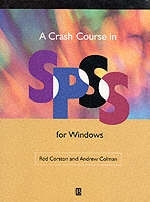
A Crash Course in SPSS for Windows
Blackwell Publishers (Verlag)
978-0-631-21771-8 (ISBN)
- Titel ist leider vergriffen;
keine Neuauflage - Artikel merken
This simple, user-friendly introduction to SPSS for Windows has now been updated so that it can be used with Versions 10 and 11 of the software, and includes two completely new chapters on log-linear analysis and factor analysis. A new supporting website allows users to download the datasets used in the book direct from the internet. The second edition has been greatly improved in the light of feedback from usability trials but retains all of the features that have made the text so attractive to students and teachers: The material is concise and focused, enabling most users to learn the basics comfortably in about 10 easy hours. All the most widely used statistical techniques and graphic facilities in SPSS for Windows are clearly described. Every statistical procedure is explained with the help of a step-by-step analysis of a numerical example. All computational examples are taken from real data from published research. The authors have chosen small data sets to prevent the task of inputting the data becoming boring. Screen dumps on the page make it easy for students to cross between the text and the screen.
For complete beginners, the first two chapters describe the basic features of Windows and explain how to get the SPSS package up and running.The second edition continues to enable students to learn the package quickly and painlessly, assuming they have some understanding of statistical methods.Online support material to accompany this text is available at http://www blackwellpublishing.com/corston
Rod Corston is a part-time Lecturer in Psychology at Peterborough Regional College. Andrew Colman is Professor of Psychology at Leicester University.
Preface. Choosing an Appropriate Statistical Procedure. Where to Find Things in SPSS for Windows. 1. Introduction. Part II: Using Windows:2. Running SPSS for Windows. 3. Resizing and Moving a Window. 4. The Data Editor. 5. Entering Data. 6. Scrolling. 7. Saving Data on Disk. 8. Exiting SPSS for Windows. Part III: Loading Data from Disk and Printing:9. Loading Data from Disk. 10. Printing and Entire Data Set. 11. Printing a Selection of Data. Part IV: General Descriptive Statistics:12. Analyzing Data. 13. Means, Standard Deviations, etc. 14. Cutting and Pasting. Part V: Correlation Coefficients:15. Background. 16. Pearson's Correlation Coefficient. 17. Spearman's Rho. Part VI: Chi-Square Test:18. Background. 19. Chi-Square Test of Association. 20. Naming Variables and Labelling Values. 21. Data Input and Analysis. 22. Chi-square Goodness-of-Fit Test. Part VII: Independent-Samples and Paired-Samples T-Tests:23. Background. 24. Independent-Samples T-Test. 25. Paired-Samples T-Test. 26. One-Sample T-Test. Part VIII: Mann-Whitney U and Wilcoxon Matched-Pairs Tests:27. Background. 28. Mann-Whitney U Test. 29. Wilcoxon Matched-Pairs Test. Part IX: One-Way Analysis of Variance:30. Background. 31. Data Input. 32. Analysis. 33. Results. Part X: Multifactorial Analysis of Variance:34. Background. 35. Data Input. 36. Analysis. 37. Results. Part XI: Repeated-Measures Analysis of Variance:38. Background. 39. Data Input. 40. Analysis. 41. Results. Part XII: Multiple Regressions:42. Background. 43. Data Input. 44. Analysis. 45. Results. Part XIII: Charts and Graphs:46. Background. 47. Bar Charts. 48. Pie Charts and Simple Line Graphs. 49. Multiple Line Graphs. 50. Scatterplots. References. Index.
| Erscheint lt. Verlag | 16.12.1999 |
|---|---|
| Verlagsort | Oxford |
| Sprache | englisch |
| Maße | 172 x 244 mm |
| Gewicht | 307 g |
| Themenwelt | Informatik ► Betriebssysteme / Server ► Windows |
| Mathematik / Informatik ► Mathematik ► Computerprogramme / Computeralgebra | |
| Sozialwissenschaften ► Soziologie | |
| ISBN-10 | 0-631-21771-1 / 0631217711 |
| ISBN-13 | 978-0-631-21771-8 / 9780631217718 |
| Zustand | Neuware |
| Haben Sie eine Frage zum Produkt? |
aus dem Bereich


